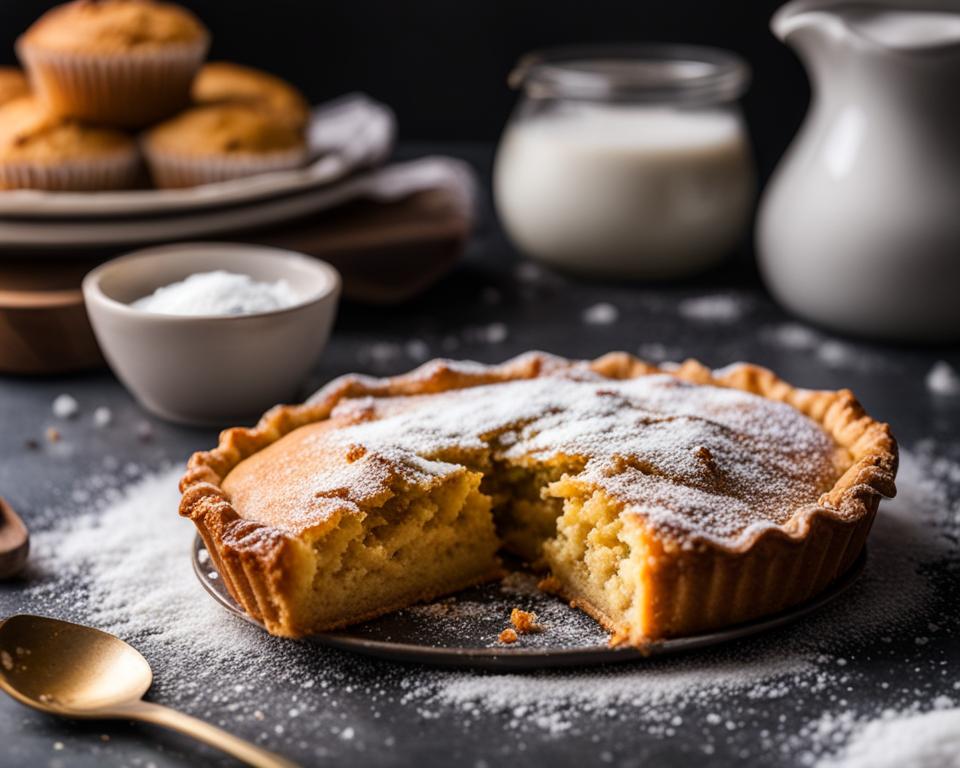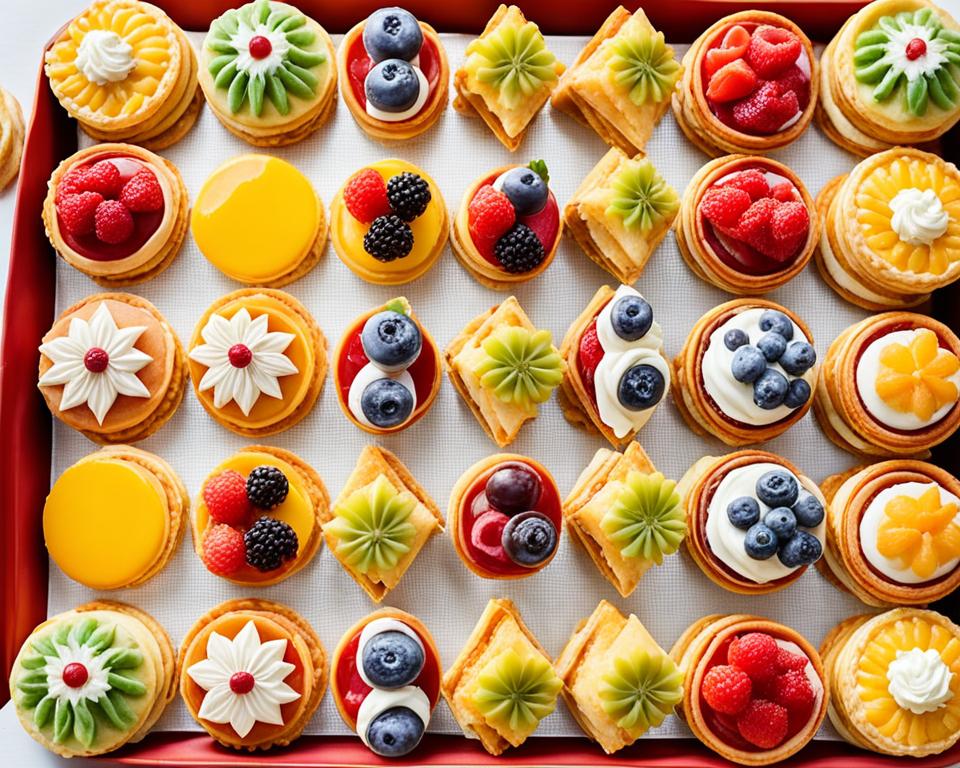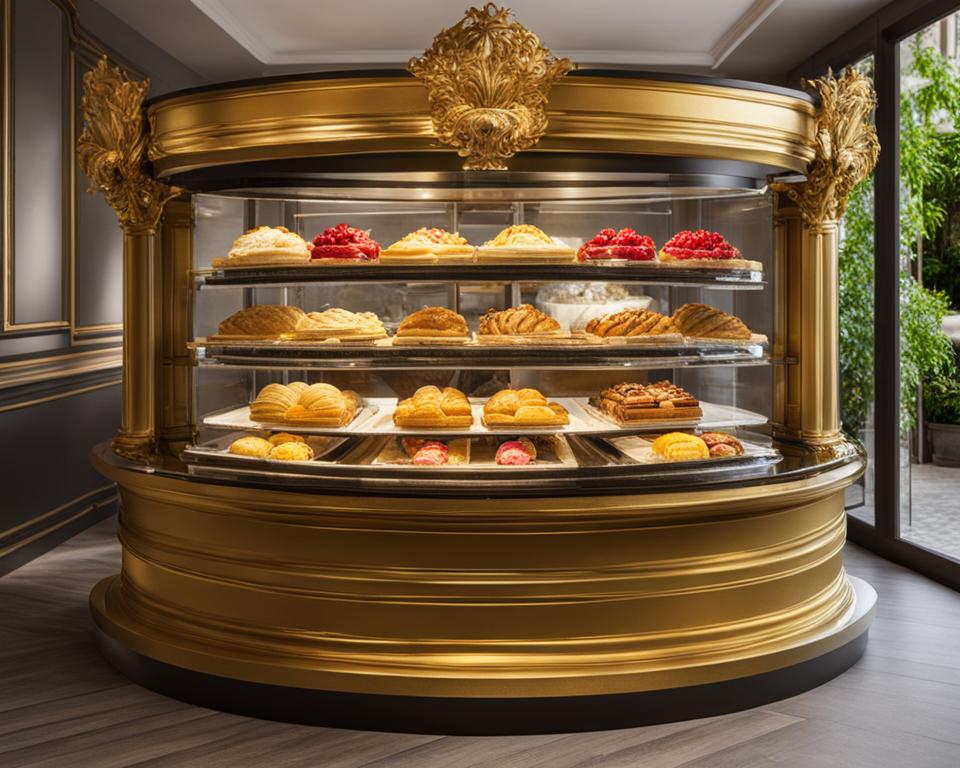Baking is both an art and a science. While cooking allows for more creativity and personal style, baking requires precision and following specific instructions. By understanding the basics, avoiding substitutions, and following these pro tips, you can avoid common baking mistakes and elevate your baking skills to create perfect treats every time.
Key Takeaways:
- Follow these pro tips to improve your baking skills and create perfect treats.
- Understanding the basics of baking is crucial for success in the kitchen.
- Avoid substitutions in recipes to maintain the desired results.
- Invest in quality baking equipment for efficient and effective baking.
- Check your oven temperature for accurate baking results.
Whether you’re a beginner baker or looking to enhance your existing skills, these pro tips will take your baking game to the next level. From measuring ingredients accurately to understanding leavening agents, each step plays a vital role in creating foolproof and delicious baked goods.
Measure Properly for Accurate Results
Proper measurement is crucial in baking. To ensure accurate results, it’s important to follow the correct methods and use the right tools when measuring your ingredients.
Measuring Dry Ingredients
Dry ingredients such as flour, sugar, and cocoa powder should be measured using a dry measuring cup. Here’s how to do it:
- Begin by fluffing the dry ingredient in its container or bag to loosen it.
- Use a spoon to scoop the ingredient into the measuring cup, filling it slightly more than needed.
- Level off the excess with a straight edge, like the back of a knife.
Remember to avoid pressing down or compacting the ingredient when measuring, as this can lead to using more than the recipe calls for and result in a dense texture.
Measuring Liquid Ingredients
Liquid ingredients, such as water, milk, and oil, should be measured using a liquid measuring cup. Here’s the proper method:
- Place the liquid measuring cup on a level surface.
- Pour the liquid into the cup while looking at it at eye level to ensure accuracy.
- Check that the liquid is exactly at the desired measurement mark.
Using clear measuring cups with pour spouts makes it easier to see the liquid level and pour without spilling.
Remember: Over- or under-measuring ingredients can throw off the balance of a recipe and result in dry or overly moist baked goods. Take the time to measure carefully for the best results.
Invest in Quality Baking Equipment
Investing in a good mixer can greatly enhance your baking experience and make the process more efficient. A Kitchen-Aid stand mixer is a popular and reliable choice, offering versatility and power to handle various baking tasks. Alternatively, an electric hand mixer is a convenient option for smaller baking projects or for those with limited counter space.
When using a mixer, it’s essential to have room temperature ingredients for optimal results. Room temperature butter and eggs blend more easily, ensuring proper incorporation and a smoother batter. This leads to better texture and a more consistent bake.
Using a high-quality mixer and incorporating room temperature ingredients into your recipes can elevate your baking results to a whole new level. It allows for better control and ensures thorough mixing, resulting in superior texture and flavor in your baked goods.
Comparison of Kitchen-Aid Stand Mixer and Electric Hand Mixer
| Feature | Kitchen-Aid Stand Mixer | Electric Hand Mixer |
|---|---|---|
| Power | 500 to 1000 watts | 100 to 250 watts |
| Mixing Speeds | Multiple speed settings | 3 to 9 speed settings |
| Attachments | Various attachments available for different baking tasks | Limited attachments |
| Size and Weight | Larger and heavier | Compact and lightweight |
| Price Range | $200 to $500+ | $30 to $100+ |
Check Your Oven Temperature for Accuracy
When it comes to baking, accuracy is key, and that starts with your oven temperature. Ensuring that your oven is heating to the correct temperature is essential for achieving perfect bakes every time.
An oven thermometer is a handy tool that can help you determine if your oven is maintaining the right temperature. Simply place the thermometer in the center of the oven and preheat it to the desired baking temperature. The thermometer will provide an accurate reading, allowing you to adjust accordingly if needed.
It’s important to note that opening the oven door during baking can cause a significant drop in temperature and affect the outcome of your baked goods. Avoid frequently checking on your bakes, as this can disrupt the baking process and lead to inconsistent results.
By regularly checking and calibrating your oven temperature with an oven thermometer, you can confidently bake with precision and achieve accurate and consistent results.
| Benefits of checking oven temperature | |
|---|---|
| 1. Perfectly Baked Goods: Ensuring the correct oven temperature allows your baked goods to bake evenly and thoroughly, resulting in perfectly cooked treats. | |
| 2. Avoid Waste: Accurate oven temperature prevents undercooked or burnt baked goods, saving you time, effort, and ingredients. | |
| 3. Consistency: Keeping a consistent oven temperature guarantees consistent results, making it easier to replicate your favorite recipes. | |
| 4. Time Efficient: With an accurate oven temperature, you can confidently follow baking times, knowing that your treats will be baked to perfection. |
Don’t let inaccurate oven temperatures hinder your baking success. Invest in an oven thermometer for precise temperature control and bake your way to delicious perfection every time.
Avoid Substitutions for Best Results
Baking is a science, and substitutions can alter the chemistry of a recipe. While small changes, such as adding nuts or swapping zests, may not affect the outcome significantly, substituting essential ingredients like all-purpose flour, butter, or eggs can lead to undesirable results. Stick to the recipe for the best baking success.
When it comes to baking, precision is key. Each ingredient plays a vital role in creating the desired texture, flavor, and structure of your baked goods. To achieve consistent and delicious results, it’s important to understand the purpose of each ingredient and the role it plays in the chemistry of baking.
Let’s take a closer look at these essential ingredients and why substitutions should be avoided:
All-Purpose Flour
All-purpose flour is a staple in many baking recipes. It contains a moderate amount of protein, which contributes to the structure of baked goods. Substituting it with other types of flour, such as whole wheat or gluten-free flour, can result in a denser and drier texture. Stick to all-purpose flour unless the recipe specifically calls for a different type.
Butter
Butter adds flavor, moisture, and richness to baked goods. Its unique composition of fat, water, and milk solids creates the desired texture and tenderness. Substituting butter with margarine or oil can alter the flavor and texture of the final product. When a recipe calls for butter, it’s best to use it for optimal results.
Eggs
Eggs act as binders, leavening agents, and add moisture to baked goods. They also contribute to the structure and help create a tender texture. Substituting eggs with alternatives like applesauce or flaxseed may work in some recipes but can alter the taste and texture. If you’re allergic to eggs or following a vegan diet, explore recipes specifically designed without eggs.
By understanding the importance of these key ingredients and avoiding substitutions, you can ensure that your baking endeavors yield consistent and delicious results. Remember, baking is both a science and an art, and precision plays a crucial role in achieving perfect treats every time.
Stay tuned for the next section where we will dive into the importance of mixing thoroughly without overmixing.
Mix Thoroughly without Overmixing
Overmixing can have a significant impact on the texture of your baked goods. It can lead to excessive gluten development, resulting in a chewy or tough consistency. To achieve a tender texture, it’s essential to mix the batter just enough to ensure uniformity, especially for cakes and muffins.
When making cakes and muffins, stirring the batter until it is just combined will prevent overmixing and help maintain a soft and delicate texture. Remember, a few lumps in the batter are perfectly fine, as they will dissolve during baking, resulting in a lighter and more tender crumb.
In recipes like scones and biscuits, it’s crucial to be mindful of overworking the dough. These recipes often call for incorporating cold chunks of butter, which create flaky layers in the final product. Overmixing can lead to melting the butter and compromising the desired texture. Instead, gently fold the ingredients together just until the dough comes together, ensuring the fat remains in distinct pieces and resulting in beautifully light and flaky baked goods.
Understand Leavening Agents
In the world of baking, leavening agents play a crucial role in creating those light and fluffy treats we all love. Two common leavening agents include baking powder and baking soda. Understanding how these ingredients work and their different functions will help you achieve the desired rise in your baked goods.
Baking Powder: Baking powder is a combination of baking soda, an acid, and a moisture absorber like cornstarch. Unlike baking soda, it does not require an acidic ingredient to activate. Instead, it reacts when it comes in contact with liquid. This chemical reaction produces carbon dioxide, creating air pockets in the dough or batter and causing it to rise.
Baking Soda: Baking soda, also known as sodium bicarbonate, is an alkaline compound. It needs an acidic ingredient, such as buttermilk, yogurt, lemon juice, or vinegar, to create the necessary chemical reaction for rising. When these acids react with baking soda, carbon dioxide gas is released, resulting in the expansion of the dough or batter.
In recipes that include both baking powder and baking soda, the baking powder provides additional leavening power, while the baking soda helps with browning and flavor enhancement.
When working with leavening agents, it’s essential to follow the recipe’s instructions and measurements carefully. Using too much or too little can lead to uneven rising or flat baked goods. Remember that baking is a delicate dance of chemical reactions, and accurate measurements and proper ingredient combinations are crucial.
Did You Know?
“Understanding how leavening agents work is like unlocking the magic of baking. The right combination and measurement can make all the difference in creating beautiful, airy creations.” – Renowned pastry chef, Alice Waters
| Leavening Agent | Activation Requirements | Function |
|---|---|---|
| Baking Powder | Requires only liquid | Creates air pockets and causes dough/batter to rise |
| Baking Soda | Requires an acidic ingredient | Chemical reaction produces carbon dioxide and expands dough/batter |
Understanding the science behind leavening agents and their unique roles in baking will enable you to confidently experiment with different recipes and achieve consistent and delicious results.
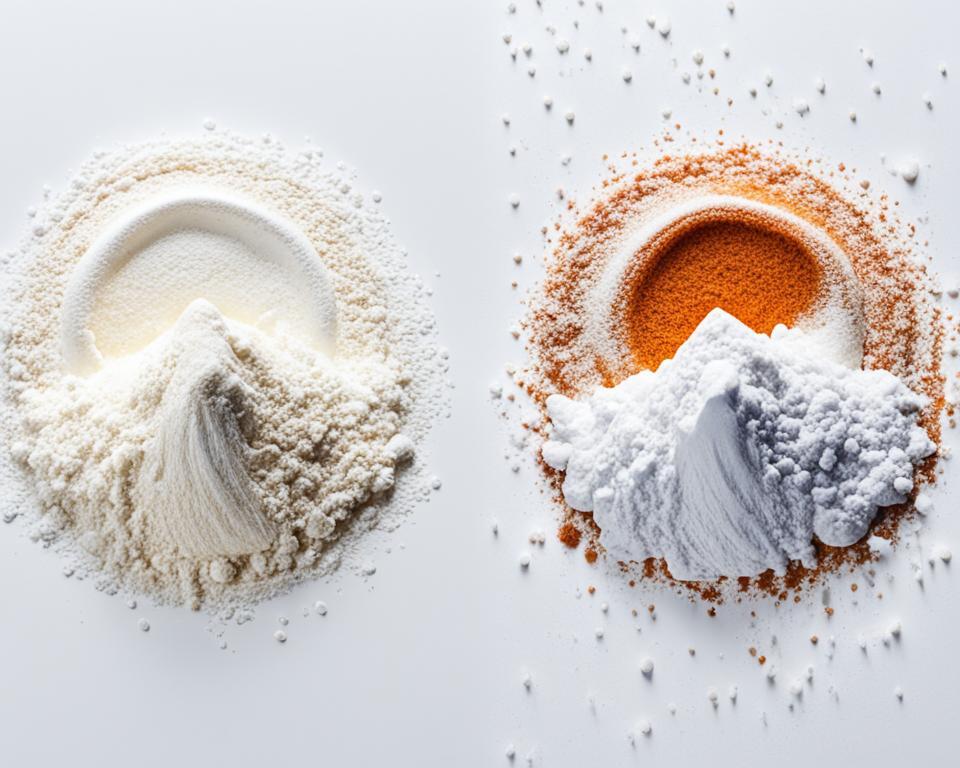
Properly Prepare Baking Pans
When it comes to baking, proper preparation of your baking pans is essential for ensuring your treats come out perfectly. Using parchment paper or heavy-duty nonstick foil to line your pans can make the process easier and prevent sticking. Additionally, greasing your pans with nonstick spray or flour ensures quick and effective coverage.
If you’re unsure which method to use, consider the following options:
Parchment Paper:
Parchment paper is a versatile and convenient option for lining baking pans. It provides a nonstick surface and helps prevent food from sticking to the pan. Simply cut a piece of parchment paper to fit the bottom of the pan, and your baked goods will easily lift off without leaving any residue behind.
Nonstick Foil:
A heavy-duty nonstick foil is another excellent choice for lining baking pans. It offers the benefit of easy removal and cleanup, just like parchment paper. The nonstick coating on the foil ensures that your baked goods won’t stick to the pan, allowing for effortless release.
Both parchment paper and nonstick foil serve the same purpose, so it ultimately boils down to personal preference. Some bakers prefer the convenience and reusability of nonstick foil, while others appreciate the ease of parchment paper. Whichever option you choose, you can be confident that your baked goods will turn out beautifully.
Pro Tip: If you frequently bake, consider investing in silicone baking mats. These reusable mats are more durable than parchment paper and provide a nonstick surface for easy release. They are also environmentally friendly as they can be used multiple times.
“Using parchment paper or nonstick foil to line your baking pans is a game-changer. It ensures easy removal and cleanup, saving you valuable time in the kitchen.”
Use Quality Ingredients for Better Flavor
The quality of your ingredients is key to achieving superior taste and texture in your baked goods. When it comes to baking, choosing high-quality ingredients can make all the difference. Here are a few essentials to consider:
1. High-Quality Flour
Selecting the right flour is crucial for achieving the desired texture and structure in your baked goods. Look for high-quality flour that is finely milled and has a consistent protein content. Brands like King Arthur Flour and Bob’s Red Mill offer excellent options for bakers.
2. Unsalted Butter
Using unsalted butter allows you to have better control over the amount of salt in your recipes. It gives your baked goods a pure, rich buttery flavor. Brands like Land O’Lakes and Kerrygold are known for their high-quality unsalted butter sticks.
3. Pure Vanilla Extract
Investing in pure vanilla extract can elevate the taste of your baked goods. Pure vanilla extract contains real vanilla beans, lending a deep and aromatic flavor. Nielsen-Massey and McCormick are reputable brands that offer high-quality pure vanilla extract.
4. Fresh Eggs
Fresh eggs are essential for binding and adding moisture to your recipes. They contribute to the overall texture and structure of your baked goods. Look for farm-fresh eggs or brands that prioritize freshness, such as Organic Valley and Vital Farms.
| Ingredient | Recommended Brands |
|---|---|
| Flour | King Arthur Flour, Bob’s Red Mill |
| Butter | Land O’Lakes, Kerrygold |
| Vanilla Extract | Nielsen-Massey, McCormick |
| Eggs | Organic Valley, Vital Farms |
By using high-quality ingredients in your baking, you can enhance the flavor and overall enjoyment of your creations. Remember to select reputable brands that prioritize quality to ensure the best possible results.
Now that you know the importance of quality ingredients, let’s move on to the next section and explore another crucial aspect of successful baking!
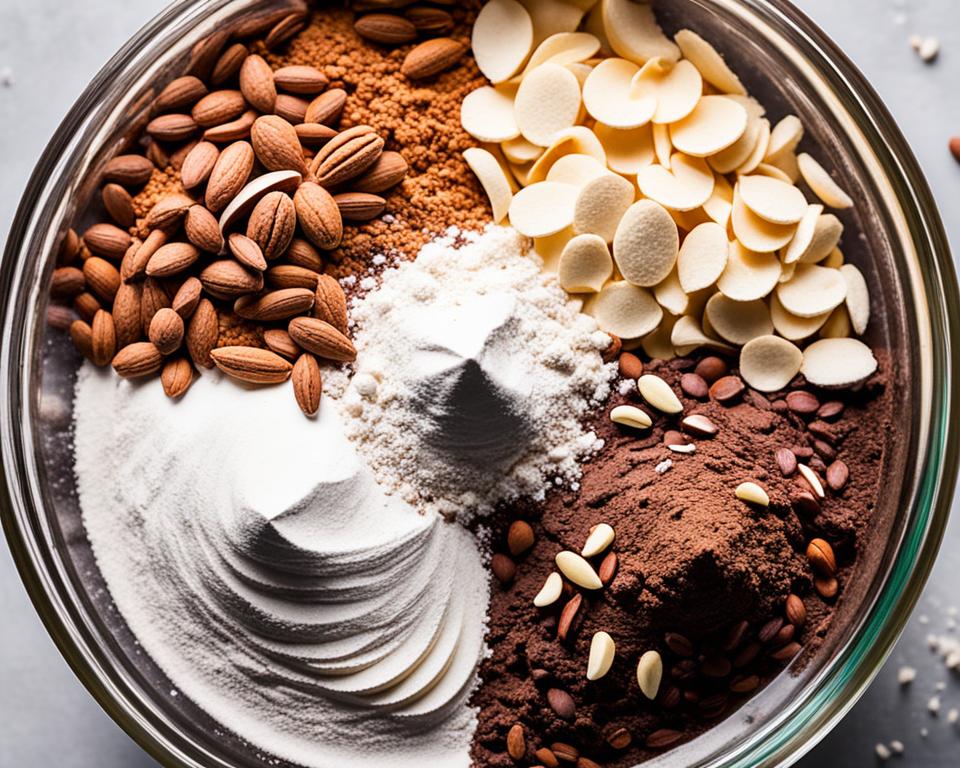
Conclusion
Perfecting your baking skills is a continuous journey. Through practice and dedication, anyone can elevate their baking skills to create delicious treats. Remember to be patient with yourself as you learn and experiment with new flavors and techniques.
A valuable tool in your baking journey is keeping a baking journal. By recording your recipes, observations, and adjustments, you can track your progress and refine your techniques over time. This allows for continuous improvement in your baking skills, ensuring consistent and impressive results.
Joining a baking community can also accelerate your growth as a baker. Connecting with like-minded individuals who share the same passion for baking provides valuable insights, tips, and support. Engaging with the baking community allows you to learn from others, exchange ideas, and celebrate your successes together.
So, embrace the joy of baking and continue to enhance your skills. With practice, a baking journal, and the support of the baking community, your baking creations will only get better. Happy baking!
FAQ
What are some pro baking tips for perfecting my baking skills?
By understanding the basics, avoiding substitutions, and following these pro tips, you can avoid common baking mistakes and elevate your baking skills to create perfect treats every time.
How should I measure ingredients properly for accurate results?
Using measuring cups or a digital scale to measure dry ingredients ensures accuracy. The spoon and level method involves spooning the ingredient into a dry measuring cup and leveling it off with a straight edge. Liquid ingredients should be measured using clear measuring cups with pour spouts.
What baking equipment should I invest in?
Investing in a good mixer, such as a Kitchen-Aid stand mixer or an electric hand mixer, can make your baking process more efficient. Additionally, using room temperature ingredients, such as butter and eggs, ensures proper incorporation and better results in your baked goods.
How can I check my oven temperature for accuracy?
Using an oven thermometer can help you determine if your oven is heating to the correct temperature. Opening the oven door during baking can disrupt the temperature and affect the baking process.
Can I make substitutions in baking recipes?
Baking is a science, and substitutions can alter the chemistry of a recipe. Stick to the recipe for the best baking success. Small changes, such as adding nuts or swapping zests, may not affect the outcome significantly, but substituting essential ingredients like flour, butter, or eggs can lead to undesirable results.
How can I mix thoroughly without overmixing?
Overmixing can lead to gluten development, resulting in a chewy or tough texture. Stir the batter just until it is uniform, especially in cakes and muffins. Avoid overworking the dough, especially in recipes like scones and biscuits, to maintain the cold chunks of butter, which create tender and flaky baked goods.
What are the differences between baking powder and baking soda?
Baking powder and baking soda are leavening agents used to make baked goods rise. Baking soda requires acidic ingredients to activate, while baking powder needs only liquid. Understanding their different functions will help you use them correctly in recipes and achieve the desired rise in your baked goods.
How should I properly prepare baking pans?
Using parchment paper or heavy-duty nonstick foil to line baking pans makes for easy removal and cleanup. Greasing pans with nonstick spray or flour ensures quick and effective coverage. Good quality foil prevents sticking, and silicone mats are reusable and more durable than parchment paper.
What is the importance of using quality ingredients in baking?
The quality of your ingredients impacts the taste and texture of your baked goods. Opt for high-quality flour, unsalted butter, pure vanilla extract, and fresh eggs whenever possible. Choosing reputable brands can make a significant difference in the outcome of your baking.
How can I continue to improve my baking skills?
Perfecting your baking skills is a continuous journey. Practice patience, experiment with new flavors and techniques, and keep a record of your recipes in a baking journal. Joining a baking community can provide valuable insights and support as you continue to improve and share your delicious creations with others.

